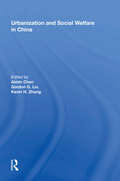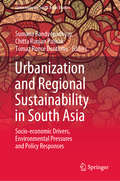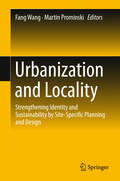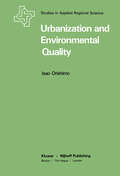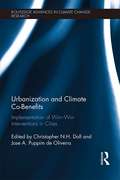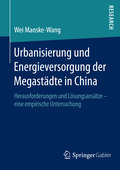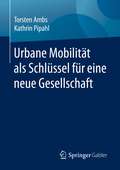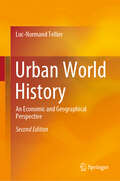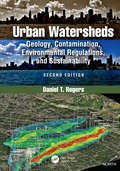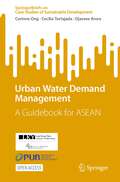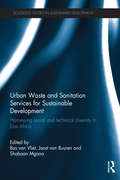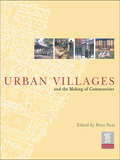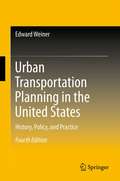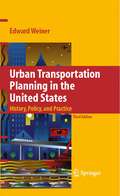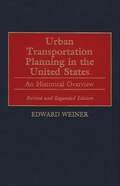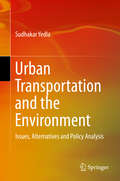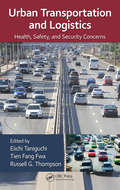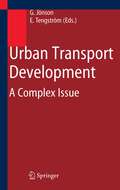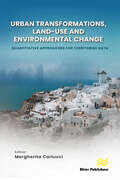- Table View
- List View
Urbanization and Social Welfare in China
by Gordon G. LiuChina's urban population growth rate has doubled in the past 20 years and the Chinese government has made further urbanization a developmental priority. How Chinese cities cope with such rapid population increases has become a question of critical concern. This book provides an analysis of the welfare implications of China's urbanization, the development of the labour market including migration between rural and urban sectors, and natural and social environmental issues arising from urbanization. The book covers both academic and policy perspectives and, together with its sister volume Urban Transformation in China, brings together a comprehensive and multi-disciplinary overview of China's urbanization.
Urbanization and Regional Sustainability in South Asia: Socio-economic Drivers, Environmental Pressures and Policy Responses (Contemporary South Asian Studies)
by Sumana Bandyopadhyay Chitta Ranjan Pathak Tomaz Ponce DentinhoThis book examines urbanization and migration processes in South Asia. By analyzing the socio-economic impacts and infrastructural, environmental and institutional aspects of different conurbations, it highlights conflicts over agricultural land as well as the effects on health, education, poverty and the welfare of children, women and old people. The authors also explore issues of mobility; connectivity and accessibility of public services, and discuss the effective use of new urban-management tools, such as the concept of smart cities and urban spatial monitoring.
Urbanization and Locality: Strengthening Identity and Sustainability by Site-Specific Planning and Design
by Fang Wang Martin ProminskiBased on a discussion of conflicts in the urbanization process, this book provides theoretical and practical solutions for the preservation and development of urban localities. On the basis of informative case studies, it reveals the similarities and unique aspects of urbanization in Germany and China. The process of urban growth and the future trend of locality and urbanization are also examined. The book gathers contributions from architects, landscape designers, environmental engineers, urban planners and geographers, who analyze urban issues from their individual perspectives and provide methods for preserving and developing urban localities. As such, it expresses responses to urban development trends against the backdrop of sustainability in the 21st century.
Urbanization and Environmental Quality (Studies in Applied Regional Science #21)
by I. OrishimoThe purpose of this monograph is to clarify the effect of environmental change on the process of urbanization. The research attempts to uncover the similarities as well as the differences across countries of the charac teristics of environmental effects on cities and metropolitan areas during the process of industrial development. Over the past several decades, a notable behavioral shift has been observed in many developed countries. People appear to be switching from an almost exclusive concern for material (commodity) consumption to a broader set of concerns that includes interest in so-called environ mental problems and in improving the quality of life (USEPA 1973). These new areas of concern include, of course, the problems of pollution, congestion, and, in general, environmental degradation in urban areas. People seem to be becoming increasingly conscious of the physical as well as the social environment. Richard L. Morrill described the situation in the United States as follows: Evidently many are still moving [their residences] for amenity values, into regions they like, irrespective of job opportunities. While movement to the traditional amenity areas of Florida and Arizona continues, there has been a dramatic shift away from California, or from metropolitan areas generally, to xv xvi INTRODUCTION the Pacific Northwest, the Rocky Mountains, upper New England, and even to the Ozarks, Appalachia, and Upper Michigan. [Quoted in Berry and Gillard 1977, p.
Urbanization and Climate Co-Benefits: Implementation of win-win interventions in cities (Routledge Advances in Climate Change Research)
by Christopher N.H. Doll and Jose A. Puppim de OliveiraUrban areas are increasingly contributing to climate change while also suffering many of its impacts. Moreover, many cities, particularly in developing countries, continue to struggle to provide services, infrastructure and socio-economic opportunities. How do we achieve the global goals on climate change and also make room for allowing global urban development? Increasing levels of awareness and engagement on climate change at the local level, coupled with recent global agreements on climate and development goals, as well as the New Urban Agenda emerging from Habitat III, present an unprecedented opportunity to radically rethink how we develop and manage our cities. Urbanization and Climate Co-Benefits examines the main opportunities and challenges to the implementation of a co-benefits approach in urban areas. Drawing on the results of empirical research carried out in Brazil, China, Indonesia, South Africa, India and Japan, the book is divided into two parts. The first part uses a common framework to analyse co-benefits across the urban sectors. The second part examines the tools and legal and governance perspectives at the local and international level that can help in planning for co-benefits. This book will be of great interest to students, practitioners and scholars of urban studies, climate/development policy and environmental studies.
Urbanization and Climate Co-Benefits: Implementation of win-win interventions in cities (Routledge Advances in Climate Change Research)
by Christopher N. H. Doll Jose A. Puppim De OliveiraUrban areas are increasingly contributing to climate change while also suffering many of its impacts. Moreover, many cities, particularly in developing countries, continue to struggle to provide services, infrastructure and socio-economic opportunities. How do we achieve the global goals on climate change and also make room for allowing global urban development? Increasing levels of awareness and engagement on climate change at the local level, coupled with recent global agreements on climate and development goals, as well as the New Urban Agenda emerging from Habitat III, present an unprecedented opportunity to radically rethink how we develop and manage our cities. Urbanization and Climate Co-Benefits examines the main opportunities and challenges to the implementation of a co-benefits approach in urban areas. Drawing on the results of empirical research carried out in Brazil, China, Indonesia, South Africa, India and Japan, the book is divided into two parts. The first part uses a common framework to analyse co-benefits across the urban sectors. The second part examines the tools and legal and governance perspectives at the local and international level that can help in planning for co-benefits. This book will be of great interest to students, practitioners and scholars of urban studies, climate/development policy and environmental studies.
Urbanisierung und Energieversorgung der Megastädte in China: Herausforderungen und Lösungsansätze – eine empirische Untersuchung
by Wei Manske-WangWei Manske-Wang analysiert den Zusammenhang zwischen der Urbanisierung im Rahmen der Stadtentwicklung und der zentralisierten Energieversorgungsstruktur in chinesischen Megastädten anhand einer empirischen Untersuchung, die auf Daten der vergangenen 35 Jahre zurückgreift. Aus den Ergebnissen der Studie entwickelt die Autorin eine Zukunftsprognose, welche durch eine Fallstudie für die Stadtentwicklung von Shanghai validiert wird. China spielt seit drei Jahrzehnten eine bedeutende Rolle für das Wachstum der Weltökonomie, gleichzeitig unterscheidet sich diese Volkswirtschaft in vielen Aspekten von den hierzulande bekannten Mustern. Die Autorin behandelt den gesamten Themenkomplex aus chinesischer Perspektive.
Urbane Mobilität als Schlüssel für eine neue Gesellschaft
by Torsten Ambs Kathrin PipahlDas Thema Urbane Mobilität rangiert sehr hoch in nahezu allen Gesellschaftsbereichen. So ist es nicht zwingend ein alleiniges Automobilthema, sondern betrifft Branchen wie Immobilien, Handel, Hospitality, Energie und Finanzen. Die Coronakrise hat nochmals unterstrichen, wie wichtig Mobilität im Sinne von Logistik und Fortbewegung für den wirtschaftlichen Wachstumsgedanken ist. Mobilität im Sinne von geistiger Beweglichkeit stellt einen wichtigen Kulturfaktor dar, Mobilität als Synonym für Freiheit.Das vorliegende Buch fokussiert Urbane Mobilität unter den Gesichtspunkten Technologie, neue Lebensformen, neue Wirtschaftssysteme und Gesellschaft. Mobilität muss nicht nur branchenübergreifend neu gedacht, sondern als ein kultureller Veränderungsprozess in seiner Gesamtheit verstanden werden. Urbane Mobilität vereint Themenwelten von Generationenkonflikt, über Nachhaltigkeit und Klimawandel bis hin zu einem neuen Politikverständnis. Unterstützt wird die Diskussion durch Beiträge von Experten aus unterschiedlichsten Branchen.
Urban World History: An Economic and Geographical Perspective
by Luc-Normand TellierThis book seeks to deepen readers’ understanding of world history by investigating urbanization and the evolution of urban systems, as well as the urban world, from the perspective of historical analysis. The theoretical framework of the approach stems directly from space-economy, and, more generally, from location theory and the theory of urban systems.The author explores a certain logic to be found in world history, and argues that this logic is spatial (in terms of spatial inertia, spatial trends, attractive and repulsive forces, vector fields, etc.) rather than geographical (in terms of climate, precipitation, hydrography). Accordingly, the book puts forward a truly original vision of urban world history, one that will benefit economists, historians, regional scientists, and anyone with a healthy curiosity.
Urban Watersheds: Geology, Contamination, Environmental Regulations, and Sustainability, Second Edition
by Daniel T. RogersUnderstanding that the natural world beneath our feet is the point at which civilization meets the natural world is critical to the success of restoration and prevention efforts to reduce contaminant impacts and improve the global environment because of one simple fact – contaminants do not respect country borders. Contaminants often begin their destructive journey immediately after being released and can affect the entire planet if the release is in just the right amount, at just the right location, and at just the right time. Taking an interdisciplinary approach, Urban Watersheds, Geology, Contamination, Environmental Regulations, and Sustainability, Second Edition presents more than 30 years of research and professional practice on urban watersheds from the fields of environmental geology, geochemistry, risk analysis, hydrology, and urban planning. The geological characteristics of urbanized watersheds along with the physical and chemical properties of their common contaminants are integrated to assess risk factors for soil, groundwater, and air. This new edition continues to examine the urban environment and the geology beneath urban areas, evaluates the contamination that affects watersheds in urban regions, and addresses redevelopment strategies. Features of the Second Edition: Examines contaminants and the successes of environmental regulation worldwide and highlights the areas that need improvement Describes several advances in investigation techniques in urban regions that now provide a huge leap forward in data collection, resolution, and accuracy Explains the importance of understanding the geological and hydrogeologic environments of urban and developed regions Provides new and enhanced methods presented as a sustainability model for assessing risks to human health and the environment from negative human-induced contaminant impacts Includes a new chapter that surveys how environmental regulations have been successful or have failed at protecting the air, water, and land in urban areas Suitable for use as a textbook and as a professional practice reference, the book includes case studies on successful and unsuccessful approaches to contaminant remediation as well as practical methods for environmental risk assessment. PowerPoint® presentations of selected portions of the book are available with qualifying course adoption. Daniel T. Rogers is currently the Director of Environmental Affairs at Amsted Industries Inc. in Chicago, Illinois. His writings address environmental geology, hydrogeology, geologic vulnerability and mapping, contaminant fate and transport, urban geology, environmental site investigations, contaminant risk, brownfield redevelopment, and sustainability. He has taught geology and environmental chemistry at Eastern Michigan University and the University of Michigan.
Urban Watersheds: Geology, Contamination, Environmental Regulations, and Sustainability, Second Edition
by Daniel T. RogersUnderstanding that the natural world beneath our feet is the point at which civilization meets the natural world is critical to the success of restoration and prevention efforts to reduce contaminant impacts and improve the global environment because of one simple fact – contaminants do not respect country borders. Contaminants often begin their destructive journey immediately after being released and can affect the entire planet if the release is in just the right amount, at just the right location, and at just the right time. Taking an interdisciplinary approach, Urban Watersheds, Geology, Contamination, Environmental Regulations, and Sustainability, Second Edition presents more than 30 years of research and professional practice on urban watersheds from the fields of environmental geology, geochemistry, risk analysis, hydrology, and urban planning. The geological characteristics of urbanized watersheds along with the physical and chemical properties of their common contaminants are integrated to assess risk factors for soil, groundwater, and air. This new edition continues to examine the urban environment and the geology beneath urban areas, evaluates the contamination that affects watersheds in urban regions, and addresses redevelopment strategies. Features of the Second Edition: Examines contaminants and the successes of environmental regulation worldwide and highlights the areas that need improvement Describes several advances in investigation techniques in urban regions that now provide a huge leap forward in data collection, resolution, and accuracy Explains the importance of understanding the geological and hydrogeologic environments of urban and developed regions Provides new and enhanced methods presented as a sustainability model for assessing risks to human health and the environment from negative human-induced contaminant impacts Includes a new chapter that surveys how environmental regulations have been successful or have failed at protecting the air, water, and land in urban areas Suitable for use as a textbook and as a professional practice reference, the book includes case studies on successful and unsuccessful approaches to contaminant remediation as well as practical methods for environmental risk assessment. PowerPoint® presentations of selected portions of the book are available with qualifying course adoption. Daniel T. Rogers is currently the Director of Environmental Affairs at Amsted Industries Inc. in Chicago, Illinois. His writings address environmental geology, hydrogeology, geologic vulnerability and mapping, contaminant fate and transport, urban geology, environmental site investigations, contaminant risk, brownfield redevelopment, and sustainability. He has taught geology and environmental chemistry at Eastern Michigan University and the University of Michigan.
Urban Water Demand Management: A Guidebook for ASEAN (SpringerBriefs on Case Studies of Sustainable Development)
by Corinne Ong Cecilia Tortajada Ojasvee AroraThis open access book highlights knowledge and expertise in Urban Water Demand Management (WDM) in ASEAN through comprehensive literature review and analysis, as well as stakeholder consultations. It documents urban WDM policies, initiatives, and practices that have demonstrated effective implementation outcomes across various contexts and which are expected to be relevant for cities in ASEAN. A WDM typology developed for this book identifies four key WDM measures, namely: water losses, economic instruments, non-price mechanisms, and alternative water reuse systems in the ASEAN context. Case illustrations of their effective implementation in different ASEAN cities are also included.
Urban Waste and Sanitation Services for Sustainable Development: Harnessing Social and Technical Diversity in East Africa (Routledge Studies in Sustainable Development)
by Shaaban Mgana Bas Van Vliet Joost Van BuurenUrban sanitation and solid waste sectors are under significant pressure in East Africa due to the lack of competent institutional capacity and the growth of the region’s urban population. This book presents and applies an original analytical approach to assess the existing socio-technical mixtures of waste and sanitation systems and to ensure wider access, increase flexibility and ecological sustainability. It shows how the problem is not the current diversity in waste and sanitation infrastructures and services and variety of types and scales of technology, of formal and informal sector involvement, and of management and ownership modes. The book focuses instead on the lack of an integrative approach to managing and upgrading of the various waste and sanitation configurations and services so as to ensure wider access, flexibility and sustainability for the low income populations who happen to be the main stakeholders. This approach, coined "Modernized Mixtures", serves as a nexus throughout the book. The empirical core addresses the waste and sanitation challenges and debates at each scale - from the micro-level (households) to the macro-level (international support) - and is based on the results of a five-year-long interdisciplinary, empirical research program. It assesses the socio-technical diversity in waste and sanitation and provides viable solutions to sanitation and waste management in East Africa. This book provides students, researchers and professional in environmental technology, sociology, management and urban planning with an integrated analytical perspective on centralized and decentralized waste and sanitation configurations and tools for improvement in the technology, policy and management of sanitation and solid waste sectors.
Urban Waste and Sanitation Services for Sustainable Development: Harnessing Social and Technical Diversity in East Africa (Routledge Studies in Sustainable Development)
by Bas Van Vliet Joost Van Buuren Shaaban MganaUrban sanitation and solid waste sectors are under significant pressure in East Africa due to the lack of competent institutional capacity and the growth of the region’s urban population. This book presents and applies an original analytical approach to assess the existing socio-technical mixtures of waste and sanitation systems and to ensure wider access, increase flexibility and ecological sustainability. It shows how the problem is not the current diversity in waste and sanitation infrastructures and services and variety of types and scales of technology, of formal and informal sector involvement, and of management and ownership modes. The book focuses instead on the lack of an integrative approach to managing and upgrading of the various waste and sanitation configurations and services so as to ensure wider access, flexibility and sustainability for the low income populations who happen to be the main stakeholders. This approach, coined "Modernized Mixtures", serves as a nexus throughout the book. The empirical core addresses the waste and sanitation challenges and debates at each scale - from the micro-level (households) to the macro-level (international support) - and is based on the results of a five-year-long interdisciplinary, empirical research program. It assesses the socio-technical diversity in waste and sanitation and provides viable solutions to sanitation and waste management in East Africa. This book provides students, researchers and professional in environmental technology, sociology, management and urban planning with an integrated analytical perspective on centralized and decentralized waste and sanitation configurations and tools for improvement in the technology, policy and management of sanitation and solid waste sectors.
Urban Villages And The Making Of Communities
by Peter NealUrban regeneration is currently at the forefront of the political and professional agenda worldwide. There is a growing desire to identify and deliver solutions that not only define models of sustainable and identifiable urban form, but also underpin a real sense of a vibrant community. The design philosophy of Urban Villages has gained significant weight with government policy-makers, planners, designers and developers and is becoming a popular model in achieving a successful and flexible urban renaissance. This book documents both the roots of the Urban Village movement and its application in contemporary society. A series of essays by eminent practitioners offers particular urban perspectives. A detailed compendium of successful case-studies provides clear technical information.
Urban Villages: The Making of Community
by NealUrban regeneration is currently at the forefront of the political and professional agenda worldwide. There is a growing desire to identify and deliver solutions that not only define models of sustainable and identifiable urban form, but also underpin a real sense of a vibrant community. The design philosophy of Urban Villages has gained significant weight with government policy-makers, planners, designers and developers and is becoming a popular model in achieving a successful and flexible urban renaissance. This book documents both the roots of the Urban Village movement and its application in contemporary society. A series of essays by eminent practitioners offers particular urban perspectives. A detailed compendium of successful case-studies provides clear technical information. Urban Villages and the Making of Communities offers a professional resource, a teaching tool and learning aid.
Urban Villages: The Making of Communities (PDF)
by NealUrban regeneration is currently at the forefront of the political and professional agenda worldwide. There is a growing desire to identify and deliver solutions that not only define models of sustainable and identifiable urban form, but also underpin a real sense of a vibrant community. The design philosophy of Urban Villages has gained significant weight with government policy-makers, planners, designers and developers and is becoming a popular model in achieving a successful and flexible urban renaissance. This book documents both the roots of the Urban Village movement and its application in contemporary society. A series of essays by eminent practitioners offers particular urban perspectives. A detailed compendium of successful case-studies provides clear technical information. Urban Villages and the Making of Communities offers a professional resource, a teaching tool and learning aid.
Urban Transportation Planning in the United States: History, Policy, and Practice
by Edward WeinerThe development of U.S. urban transportation policy over the past half-century illustrates the changing relationships among federal, state, and local governments. This comprehensive text examines the evolution of urban transportation planning from early developments in highway planning in the 1930s to today’s concerns over sustainable development, security, and pollution control. Highlighting major national events, the book examines the influence of legislation, regulations, conferences, federal programs, and advances in planning procedures and technology. The volume provides in-depth coverage of the most significant event in transportation planning, the Federal-Aid Highway Act of 1962, which created a federal mandate for a comprehensive urban transportation planning process, carried out cooperatively by states and local governments with federal funding. Claiming that urban transportation planning is more sophisticated, costly, and complex than its highway and transit planning predecessors, the book demonstrates how urban transportation planning evolved in response to changes in such factors as the environment, energy, development patterns, intergovernmental coordination, and federal transit programs. This updated, revised, and expanded edition features two new chapters on global climate change and managing under conditions of constrained resources, and covers the impact of the most recent legislation, 50 years after the Highway Act of 1962, emphasizing such timely issues as security, oil dependence, performance measurement, and public-private sector collaboration.
Urban Transportation Planning in the United States: History, Policy, and Practice
by Edward WeinerThis comprehensive text examines the evolution of urban transportation planning in the United States, from early developments in highway planning in the 1930s to today’s concerns over sustainable development, security, and pollution control.
Urban Transportation Planning in the United States: An Historical Overview
by Edward WeinerThe development of U.S. urban transportation policy over the past 50 years illustrates the changing relationship between federal, state, and local governments. This comprehensive text examines the evolution of urban transportation planning from early developments in highway planning in the 1930s to the concern for sustainable development and pollution emissions. Focusing on major national events, the book discusses the influence of legislation, regulations, conferences, federal programs, and advances in planning procedures and technology.The book offers an in-depth look at the most significant event in transportation planning—the Federal-Aid Highway Act of 1962. Creating a federal mandate for a comprehensive urban transportation planning process carried out cooperatively by states and local governments with federal funding, this act was crucial in the spread of urban transporation. Claiming that urban transportation planning is more sophisticated, costly, and complex than its highway and transit planning predecessors, the book demonstrates how urban transportation planning evolved in response to changes in such factors as environment, energy, development patterns, intergovernmental coordination, and federal transit programs. It further illustrates how broader concerns for global climate change and sustainable development have braided the purview of transportation planning.
Urban Transportation and the Environment: Issues, Alternatives and Policy Analysis
by Sudhakar YedlaThe book deals with urban transportation planning in light of environmental sustainability and social equity. It begins with a review of the Indian urban transportation system and the issues surrounding it, and discusses the alternatives and policy directions that are being considered. It examines all the environmental issues arising out of transportation as a sector and assesses the alternatives that can be considered to improve sustainability. Further, the book not only analyses transportation modes that cater to the travel needs of the poor, so as to make them more socially equitable, but also explores measures to promote them using a multi-criteria and multi-stakeholder approach. It addresses the barriers that are bottlenecks for the implementation of cleaner fuels and modes of transport and presents an incremental approach to tackle environmental concerns, including climate change, when planning transportation in the long term. Finally, it presents the dilemma of city administrators in choosing between strategies aimed at local pollution control and those aimed at limiting global emissions. This unique book provides a comprehensive overview of “sustainable transportation.” It discusses all the important elements that are essential to transportation planners and policy makers when planning a city’s transportation. Theoretical presentations augmented by case-specific research work and the methodology used in some of the modules, make it a valuable resource for researchers working at the forefront of this area.
Urban Transportation and Logistics: Health, Safety, and Security Concerns
by Eiichi Taniguchi Tien Fang Fwa Russell G. ThompsonAlthough society has become increasingly dependent on the timely operation of logistics systems, we still face many problems regarding efficiency, the environment, energy consumption, and safety in urban transport and logistics under normal cases and in disasters. As such, understanding how to address these challenges has become essential for creat
Urban Transport Development: A Complex Issue
by Gunella Jönson Emin TengströmUrban Transport Development is a contribution to the ongoing global discussion on the future of urban transport. The main themes are how to cope with the complexity of urban transport development and the process of change including its determining factors. The role of leadership in the development process is the key issue. Main areas of discussion are the historical background, the diversity and complexity of present problems, and the outcome of attempts to promote positive future development in urban environments around the world.
Urban Transformations, Land-use, and Environmental Change: Quantitative Approaches for Territorial Data
by Margherita CarlucciThis book provides interesting insights for the identification of socioeconomic, demographic and territorial factors that affect structural disparities in local economies. Urban development is the result of demographic dynamics at the local level, connected to socioeconomic factors, and of economic growth, whose fluctuations are particularly sensitive to the economic cycle in countries, such as the ones in the Mediterranean basin, characterized by greater informality of the sector and limited public/social housing. Our objective is to provide a contribution to sustainability planning, explaining the linkage between forms of urban development and economic growth, providing policy indications for integrated spatial planning, and for cohesion policies that may leverage social and economic competitiveness.
Urban Transformations, Land-use, and Environmental Change: Quantitative Approaches for Territorial Data
by Margherita CarlucciThis book provides interesting insights for the identification of socioeconomic, demographic and territorial factors that affect structural disparities in local economies. Urban development is the result of demographic dynamics at the local level, connected to socioeconomic factors, and of economic growth, whose fluctuations are particularly sensitive to the economic cycle in countries, such as the ones in the Mediterranean basin, characterized by greater informality of the sector and limited public/social housing. Our objective is to provide a contribution to sustainability planning, explaining the linkage between forms of urban development and economic growth, providing policy indications for integrated spatial planning, and for cohesion policies that may leverage social and economic competitiveness.
